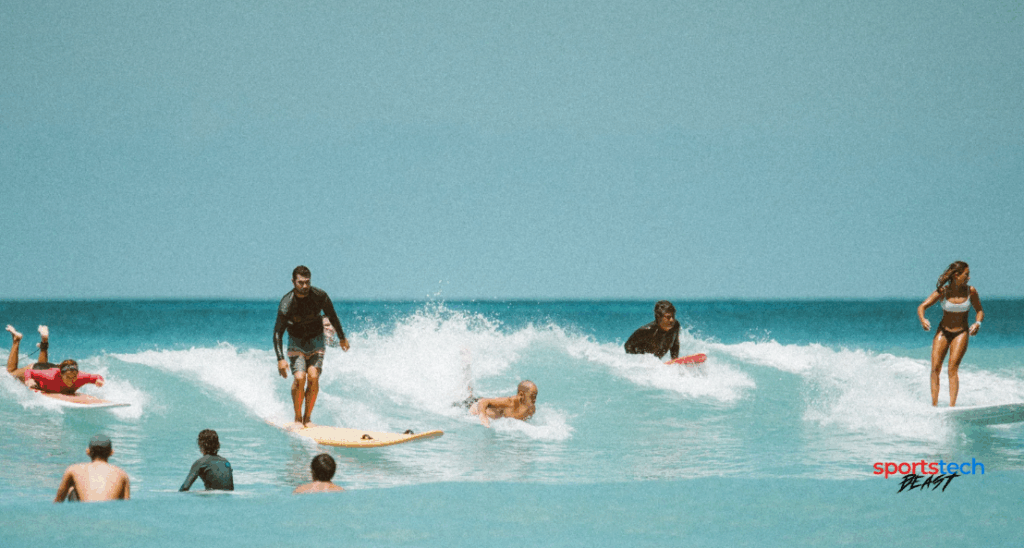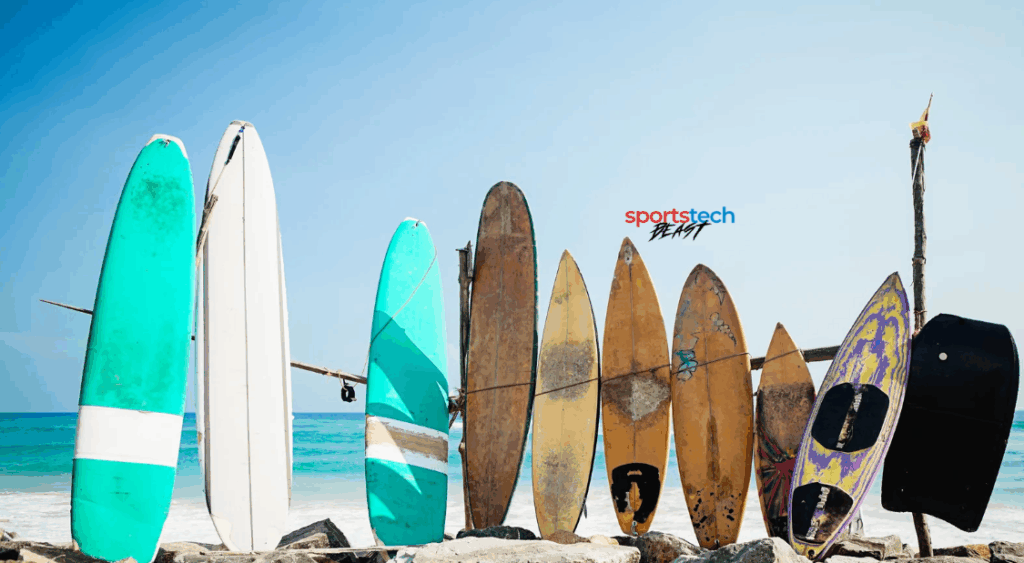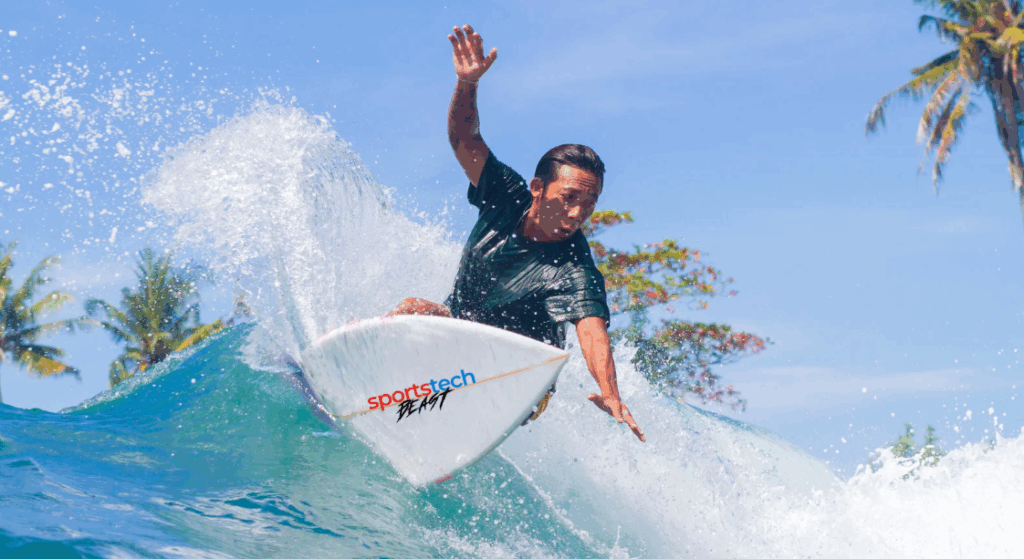You’ve watched surfers glide effortlessly across waves and wondered why it seems so difficult when you try. The truth is, surfing doesn’t have to be a frustrating experience filled with wipeouts and swallowed seawater.
Start with light beach breaks with small, forgiving waves. It creates safe, consistent waves at these sandy bottom spots. What separates successful beginners from those who give up isn’t natural talent. It’s knowing a few simple shortcuts that make the learning curve much less steep.
Choose the Right Surf Spot and Conditions
Choosing where to surf is key to your experience, especially as a beginner. Not all beaches are equal, and choosing the right surf is important for your progression and safety.
Start with mild beach breaks with smaller, softer waves. They’re much more beginner-friendly. Sandy bottoms are safer, and the waves are cleaner and consistent. The perfect setup to practice without too much stress. Avoid reef or point breaks until you have more experience.

Timing makes a big difference, too. Early mornings usually bring calmer water, lighter winds, and fewer people in the lineup. Keep an eye on the surf forecast. Aim for days with swells around 1 to 3 feet.
Develop your ocean awareness by observing how waves break and where other beginners succeed.
Use the Right Beginner-Friendly Equipment
When you first start surfing, your equipment choice can affect your learning curve and experience. Choose a foam or soft-top longboard that’s 8-9 feet long and has plenty of volume. They provide maximum surfboard balance for paddling and catching waves.
Beginner surfers should avoid shortboards until they’ve mastered the basics. Many surf lessons start with larger boards precisely because they simplify the learning process. Don’t forget essential accessories like a secure leash, wax for grip, and a properly fitting wetsuit for cooler waters.
The easy way to surf begins with forgiving equipment that builds confidence. Even experienced surfers sometimes use longboards when they want a relaxed session in smaller waves.

Learn the Basics of Paddling and Positioning
Once you have your beginner-friendly board, it’s all about dialing in your paddling and positioning. These are the real building blocks of solid surfing.
Lie on your board with your chest slightly lifted and your feet together, just behind the center. If you’re too far forward, you’ll nosedive. Too far back, and you’ll lose speed. Finding that sweet spot helps you stay balanced and glide smoothly.
Use strong, deep strokes with alternating arms when paddling, pulling water beneath you instead of just splashing at the surface. Keep your core engaged and your head up so you can see the waves coming.
To catch a wave, start paddling before it reaches you. As it gets closer, pick up your pace. That extra momentum makes your pop-up smoother. When you feel the wave lift your board, press up quickly and bring your feet underneath you in one fluid motion. It might feel awkward at first, but with practice, it’ll become second nature.

Master the Pop-Up Without Overthinking It
The pop-up motion remains the most challenging hurdle for new surfers, often causing frustration when attempted directly in the water. Before paddling out, master your pop-up technique on dry land first. Place your surfboard on sand or grass and practice the fluid motion of pushing up with your hands while simultaneously sliding your feet underneath your body.
For effective surfing for beginners, focus on one smooth movement rather than separating the motion into steps. Your front foot should land between your hands with knees bent. Practice daily until this stand-up technique becomes muscle memory. Maintaining surf safety means keeping your eyes forward, not down at your board.
Improve Balance and Reading the Ocean
Successful surfing relies on two fundamental skills: maintaining balance on your board and understanding ocean patterns. When riding waves, distribute your weight evenly with feet shoulder-width apart and knees slightly bent. Your arms aren’t just hanging. They’re active tools for adjusting balance as you surf.
Reading the ocean is equally essential to how to surf effectively. Watch the horizon for approaching sets and learn to identify which waves will break cleanly. Look for darker water, indicating deeper channels where paddling out is easier. When catching a wave, time your paddle to match its speed, then angle your takeoff slightly across the face rather than straight down.
With practice, you’ll develop an intuitive feel for both balance and wave selection, transforming frustrating sessions into flowing, enjoyable rides.
Build Confidence Through Repetition and Small Wins
Build surfing confidence by gradually focusing on practice and celebrating small successes. Instead of riding every wave perfectly, aim for standing up or catching one good wave per session.
Ride the wipeouts, too. Even pro surfers fall sometimes. Each splash teaches us about balance, timing, and how to read the wave better next time.
Watch the little victories. Perhaps you paddled out farther today, popped up quicker, or rode the wave a little longer. Those little improvements will add up to your experience. It will seem like you are progressing faster than you think. Remember that consistency beats intensity. Regular short sessions will improve your skills more than occasional marathon attempts.
Frequently Asked Questions
How Do I Duck Dive Through Breaking Waves?
Push your board underwater by placing your hands on the rails, pushing down, and using your knee to drive the tail under. Do it just before the wave hits you.
When Is the Best Time of Day to Go Surfing?
Early morning is typically the best time to go surfing. You’ll find calmer winds, cleaner waves, and fewer crowds. Dawn patrol (sunrise sessions) often offers the most pristine conditions for your surf session.
How Do I Repair Dings on My Surfboard?
Clean the ding, let it dry, apply resin and fiberglass patch, then sand smooth. For small repairs, use a ding repair kit. Deeper damage might require professional help.
What Should I Eat Before a Surf Session?
Eat something light but energizing before surfing. Choose easily digestible carbs like a banana, granola bar, or toast with honey about 30-60 minutes before paddling out.
How Do I Avoid Surfing Etiquette Mistakes That Anger Other Surfers?
Wait your turn in the lineup, don’t drop in on others’ waves, paddle around (not through) the lineup, apologize for mistakes, respect locals, and don’t hog waves. Awareness of others shows respect.





